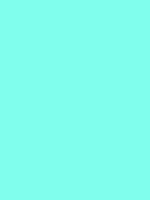#80feed Color Information
In a RGB color space, hex #80feed is composed of 50.2% red, 99.6% green and 92.9% blue. Whereas in a CMYK color space, it is composed of 49.6% cyan, 0% magenta, 6.7% yellow and 0.4% black. It has a hue angle of 171.9 degrees, a saturation of 98.4% and a lightness of 74.9%. #80feed color hex could be obtained by blending #ffffff with #01fddb. Closest websafe color is: #99ffff.
-
- R 50
- G 100
- B 93
-
- C 50
- M 0
- Y 7
- K 0
● #80feed color description : Soft cyan.
#80feed Color Conversion
The hexadecimal color #80feed has RGB values of R:128, G:254, B:237 and CMYK values of C:0.5, M:0, Y:0.07, K:0. Its decimal value is 8453869.
| Hex triplet | 80feed | #80feed |
|---|---|---|
| RGB Decimal | 128, 254, 237 | rgb(128,254,237) |
| RGB Percent | 50.2, 99.6, 92.9 | rgb(50.2%,99.6%,92.9%) |
| CMYK | 50, 0, 7, 0 | |
| HSL | 171.9°, 98.4, 74.9 | hsl(171.9,98.4%,74.9%) |
| HSV (or HSB) | 171.9°, 49.6, 99.6 | |
| Web Safe | 99ffff | #99ffff |
| CIE-LAB | 92.391, -39.177, -2.69 |
|---|---|
| XYZ | 59.625, 81.583, 92.721 |
| xyY | 0.255, 0.349, 81.583 |
| CIE-LCH | 92.391, 39.269, 183.928 |
| CIE-LUV | 92.391, -54.174, 2.249 |
| Hunter-Lab | 90.323, -40.232, 2.362 |
| Binary | 10000000, 11111110, 11101101 |
Color Schemes with #80feed
Alternatives to #80feed
Below, you can see some colors close to #80feed. Having a set of related colors can be useful if you need an inspirational alternative to your original color choice.
#80feed Preview
This text has a font color of #80feed.
<span style="color:#80feed;">Text here</span>This paragraph has a background color of #80feed.
<p style="background-color:#80feed;">Content here</p>This element has a border color of #80feed.
<div style="border:1px solid #80feed;">Content here</div>.text {color:#80feed;}.background {background-color:#80feed;}.border {border:1px solid #80feed;}Shades and Tints of #80feed
A shade is achieved by adding black to any pure hue, while a tint is created by mixing white to any pure color. In this example, #000908 is the darkest color, while #f5fffe is the lightest one.
-
#000908
#000908rgb(0,9,8) -
#001d19
#001d19rgb(0,29,25) -
#00302a
#00302argb(0,48,42) -
#01443b
#01443brgb(1,68,59) -
#01574b
#01574brgb(1,87,75) -
#016b5c
#016b5crgb(1,107,92) -
#017e6d
#017e6drgb(1,126,109) -
#01917e
#01917ergb(1,145,126) -
#01a58f
#01a58frgb(1,165,143) -
#01b8a0
#01b8a0rgb(1,184,160) -
#02ccb1
#02ccb1rgb(2,204,177) -
#02dfc1
#02dfc1rgb(2,223,193) -
#02f3d2
#02f3d2rgb(2,243,210)
-
#0bfddc
#0bfddcrgb(11,253,220) -
#1ffddf
#1ffddfrgb(31,253,223) -
#32fde2
#32fde2rgb(50,253,226) -
#46fee5
#46fee5rgb(70,254,229) -
#59fee7
#59fee7rgb(89,254,231) -
#6dfeea
#6dfeeargb(109,254,234) -
#80feed
#80feedrgb(128,254,237) -
#93fef0
#93fef0rgb(147,254,240) -
#a7fef3
#a7fef3rgb(167,254,243) -
#bafef5
#bafef5rgb(186,254,245) -
#cefff8
#cefff8rgb(206,255,248) -
#e1fffb
#e1fffbrgb(225,255,251) -
#f5fffe
#f5fffergb(245,255,254)
Tones of #80feed
A tone is produced by adding gray to any pure hue. In this case, #bbc3c2 is the less saturated color, while #80feed is the most saturated one.
-
#bbc3c2
#bbc3c2rgb(187,195,194) -
#b6c8c5
#b6c8c5rgb(182,200,197) -
#b1cdc9
#b1cdc9rgb(177,205,201) -
#acd2cd
#acd2cdrgb(172,210,205) -
#a7d7d0
#a7d7d0rgb(167,215,208) -
#a2dcd4
#a2dcd4rgb(162,220,212) -
#9ee0d7
#9ee0d7rgb(158,224,215) -
#99e5db
#99e5dbrgb(153,229,219) -
#94eadf
#94eadfrgb(148,234,223) -
#8fefe2
#8fefe2rgb(143,239,226) -
#8af4e6
#8af4e6rgb(138,244,230) -
#85f9e9
#85f9e9rgb(133,249,233) -
#80feed
#80feedrgb(128,254,237)
Color Blindness Simulator
Below, you can see how #80feed is perceived by people affected by a color vision deficiency. This can be useful if you need to ensure your color combinations are accessible to color-blind users.
